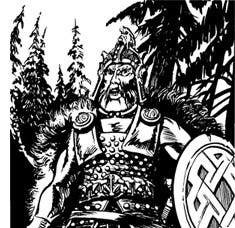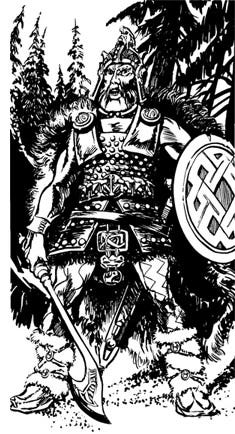It is a dark and stormy night. In the dark, dank cellar of the house by the woods, a peculiar group huddles around an altar covered in geometric symbols and runes. These people—society’s outcasts—gather once every lunation, muttering spells, making bargains, and summoning otherworldly creatures. The unkempt man at the head of the alter sets his bloodshot eyes on the man across from him. In a hoarse voice, he asks, “who do you worship?”
“Uh, my dwarf paladin worships Fitur the god of Fighting because he likes to fight. Also, I’m going with oath of conquest because he’s going to be like a crusader. Anyway, can we start the session already?”
For a game that set off the Satanic Panic, I find most D&D (and similar TTRPG) games to be somewhat lacking in the religious department. Often it is mostly a background thing to explain how clerics and paladins get their power while giving some cool lore or wacky cultists to fight. I am, of course, happy to see these tropes in any campaign—but there is so much room to go deeper with religion. Drawing from history, religion was such an important part of life that it hardly deserved to be cast to the wayside.
Generally, your standard RPG setting like Greyhawk or The Forgotten Realms has some sort of catholic-flavored paganism. They bring the religious diversity of pagan gods into a medieval (read: Christian) aesthetic. This gets you your Arthurian knight, the paladin, fighting side-by-side with the ancient Celtic priest, the Druid. This is great for giving players lots of options for how to style their character but less great if you want your world to be anything other than a fantasy representation of early medieval Europe in its process of being Christianized. I believe many campaigns would benefit from moving away from the everything-but-the-kitchen-sink-style of worldbuilding into something more focused.
Let’s consider a campaign setting dialed toward the pagan end of the spectrum. I will mostly be referencing Germanic paganism for this example because it is the historical culture I am most familiar with (note that this includes most of northern Europe from England to parts of Eastern Europe). Pagan gods are not all-powerful, nor are they omniscient or benevolent. They have different goals, biases, flaws and are more often worshipped out of reverence and respect and less out of love and devotion. They are given offerings in exchange for protection, favors, or just appeasement. On paper, this is pretty standard for your traditional D&D setting. But what we don’t really see is the implications and effects of this worldview on the setting. A pagan worldview is not one that is likely to lead to the traditions of medieval Europe nor the fantasy version of it with the holy knights, ornamented cathedrals, and battles between angels and demons.
Firstly, no place of worship was more important than the home, or more specifically, the hearth. Every proper home should have an altar around the hearth where offerings are prepared and daily prayer rituals are done. These alters can contain different shrines to different gods as well as shrines to non-deities such as ancestors and house spirits. That’s right, gods are not the only ones that receive prayers and offerings. It is just as important for a villager to give offerings to their local Kobold house spirit to keep them from causing trouble. On top of that, their ancestors are constantly watching, judging, and influencing from the afterlife. PCs and NPCs alike will want to pray to their ancestors for wisdom and seek to please them.
In general, the objects of worship: gods, spirits, and ancestors should be much more day-to-day than normally seen in fantasy settings. Farmers prayed to Thor to protect their cattle while housewives prayed to Freja to send cats to deal with mice. This doesn’t mean your adventurers can’t also summon the strength of a god to divine smite a giant, only that the gods are for everyone—not just high-level adventurers.
Another important effect a pagan worldview would have on a campaign setting is the cyclical view of time. Unlike the modern linear way of seeing time. Pagan societies saw time as a cycle. Myths were not necessarily something that happened long ago; rather, they are happening concurrently with the world’s natural cycles. For example, the creation myth did not just happen “in the beginning”, but it is repeated at the start of each year when the frozen ground comes back to life. Historically, this is represented in ritual song and dance. But since we have the freedom of fantasy, this can be as literal or as figurative as you want it to be. Likewise, the end of the year represents the apocalypse. In Norse myth, the coming of winter parallels the attack of the frost giants that inevitably leads to Ragnarok. That’s bound to give you some ideas.
The historian Mircea Eliade claims that part of the reason that Christianity took off and overtook paganism so quickly is because it brought the mythical/sacred timeline into the literal timeline by putting God into physical history in the form of Jesus Christ, thus breaking the time cycle. This change in religious thinking came about because times were changing. For the first time in thousands of years, someone’s life can be notable different from that of their father’s or grandfather’s. The rise and fall of emperors and the ebb and flow of the Empire’s borders made life far more unpredictable than ever before. Suddenly the tree spirit that your family worshipped for centuries was being chopped down and sent to Rome for lumber. Suddenly, there is a need for calendars and linear time.
But enough with the history. You may be thinking that an adventurer’s life is bound to be more interesting than your standard villager and thus a cyclical view of time wouldn’t make much sense for them. So, how do we reconcile this while keeping our pagan worldview? Allow me to present helix time: a combination of linear and cyclical time. In helix time, history goes on, events happen, and dates are remembered. But at the same time, the yearly cycle remains, the frost giants are fought in the winter and the world is—in some sense—destroyed before being reborn in the spring. However, it will not be exactly the same every year. While frost giants may attack one year, it may be a lych’s army the next year, or an opposing kingdom’s invasion. This also does not have to be a setting-wide event, it could instead be personal to the party. It is satisfyingly symbolic to see the world become cold and dark as the BBEG starts to set their evil plan in motion; but after months of preparation, the party defeats them just as spring is being ushered in.
So, what can players bring to the table for a pagan-centric campaign? Do we have to get rid of paladins and clerics because of their Christian origins? Certainly not. Paladins, though based on Christian knights, can easily be flavored to be a more viking-esque warror—fighting for their people/loot/whatever with the might of Thor behind them. Clerics, based on Catholic monks, are quite ahistorical anyway; medieval priests did not often find themselves in combat, and when they did, they had no limitations to blunt weapons like D&D clerics do. In the case of the Knights Templar, they are much more like paladins. This means clerics are a pretty open slate as far as paganizing them. In fact, in the Pathfinder game I am currently playing in, my character is based on a Celtic druid, but I decided to go with a cleric for my class because I wanted to prioritize healing more than the druid class allowed me. My character heals with prayers to the gods as well as herbs and other concoctions. Even non-divine classes can be adjusted to fit the pagan world better. Bards can be traveling storytellers, retelling myths and lore, and any marital classes would still be wise to give the occasional offering to a specific god, depending on the scenario, or seek the guidance of their ancestors.
Finally, if you are interested in taking this to the other end of the spectrum and making your world super Christian-themed, and eliminate the pagan themes, then I commend you for reading this far and I apologize for not going very in-depth here. While I don’t know quite enough about Medieval Christianity Europe to give as many ideas, I can recommend the setting Dolmenwood for Old School Essentials. It is a setting inspired by medieval England and has a monotheistic, Catholic-like religion with saints and a one true God. If you like Arthurian-style chivalrous, holy knights as well as whimsical English folklore, this setting is worth checking out.
As I mentioned before, religion is usually just a quick backdrop to a campaign setting or a character. To be fair, at the end of the day, religion is never going to be the most important part of a campaign setting. With that being said, it is definitely interesting enough that it warrants some more attention and should be allowed to influence other aspects of the game world. A well-thought-out religion will quickly give depth to your world and characters.
If you want to read more about religion in general, I strongly recommend Eliade’s book, The Sacred and the Profane: The Nature of Religion. A lot of my inspiration for this post came from that book.





Religion is almost always badly (or, at least, inadequately) covered in most RPGs. Personally, I've always thought that this was in part because, historically, religious observance was, for most people (even priests), usually reflexive; a more or less unthinking daily cultural activity. When we try and imagine a world where gods are real, we think we have a simple template but really, we don't. To take one example, we suffer greatly from very Victorian notions of 'the sacred' which are wholly anachronistic when one reads English medieval and early modern accounts of social attitudes to churches, priests and religious observance more generally. Famously, the mystic Margery Kempe's fellow pilgrims were so sick of her ranting that they threatened to tie her up and gag her, believing her to be insane. Late medieval and early modern churchwardens accounts are littered with examples of what would - to say the least - raise an eyebrow among the pious today. I wish I could remember now the name of the church that had to have it's pews replaced because the old ones had rotted on account of the amount of urine that they were soaked in by the congegation. All this to say that, if we try and apply modern notions of 'religion' into RPGs, we drag in elements that make it unsustainable as a world-building exercise because we import our (muddled) sense of what pre-modern societies actually meant by religon and how they practiced it.